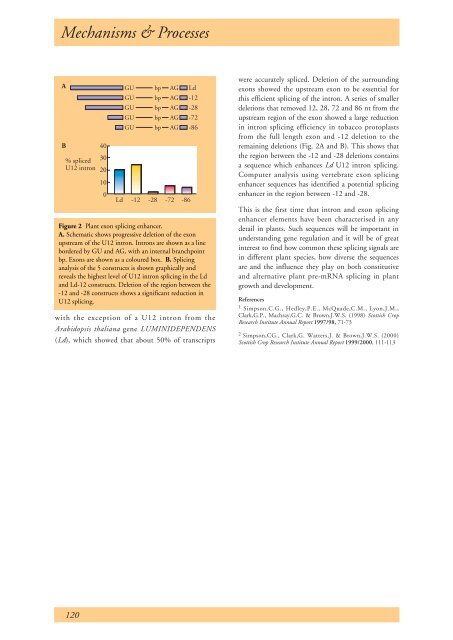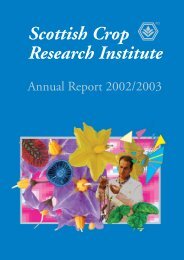SCRI Annual Report 2003/2004 - Scottish Crop Research Institute
SCRI Annual Report 2003/2004 - Scottish Crop Research Institute
SCRI Annual Report 2003/2004 - Scottish Crop Research Institute
Create successful ePaper yourself
Turn your PDF publications into a flip-book with our unique Google optimized e-Paper software.
Mechanisms & Processes<br />
A<br />
B<br />
% spliced<br />
U12 intron<br />
40<br />
30<br />
20<br />
10<br />
0<br />
GU bp AG Ld<br />
GU bp AG -12<br />
GU bp AG -28<br />
GU bp AG -72<br />
GU bp AG -86<br />
Ld -12 -28 -72 -86<br />
Figure 2 Plant exon splicing enhancer.<br />
A. Schematic shows progressive deletion of the exon<br />
upstream of the U12 intron. Introns are shown as a line<br />
bordered by GU and AG, with an internal branchpoint<br />
bp. Exons are shown as a coloured box. B. Splicing<br />
analysis of the 5 constructs is shown graphically and<br />
reveals the highest level of U12 intron splicing in the Ld<br />
and Ld-12 constructs. Deletion of the region between the<br />
-12 and -28 constructs shows a significant reduction in<br />
U12 splicing.<br />
with the exception of a U12 intron from the<br />
Arabidopsis thaliana gene LUMINIDEPENDENS<br />
(Ld), which showed that about 50% of transcripts<br />
were accurately spliced. Deletion of the surrounding<br />
exons showed the upstream exon to be essential for<br />
this efficient splicing of the intron. A series of smaller<br />
deletions that removed 12, 28, 72 and 86 nt from the<br />
upstream region of the exon showed a large reduction<br />
in intron splicing efficiency in tobacco protoplasts<br />
from the full length exon and -12 deletion to the<br />
remaining deletions (Fig. 2A and B). This shows that<br />
the region between the -12 and -28 deletions contains<br />
a sequence which enhances Ld U12 intron splicing.<br />
Computer analysis using vertebrate exon splicing<br />
enhancer sequences has identified a potential splicing<br />
enhancer in the region between -12 and -28.<br />
This is the first time that intron and exon splicing<br />
enhancer elements have been characterised in any<br />
detail in plants. Such sequences will be important in<br />
understanding gene regulation and it will be of great<br />
interest to find how common these splicing signals are<br />
in different plant species, how diverse the sequences<br />
are and the influence they play on both constitutive<br />
and alternative plant pre-mRNA splicing in plant<br />
growth and development.<br />
References<br />
1 Simpson,C.G., Hedley,P.E., McQuade,C.M., Lyon,J.M.,<br />
Clark,G.P., Machray,G.C. & Brown,J.W.S. (1998) <strong>Scottish</strong> <strong>Crop</strong><br />
<strong>Research</strong> <strong>Institute</strong> <strong>Annual</strong> <strong>Report</strong> 1997/98, 71-73<br />
2 Simpson,CG., Clark,G. Watters,J. & Brown,J.W.S. (2000)<br />
<strong>Scottish</strong> <strong>Crop</strong> <strong>Research</strong> <strong>Institute</strong> <strong>Annual</strong> <strong>Report</strong> 1999/2000, 111-113<br />
120
















